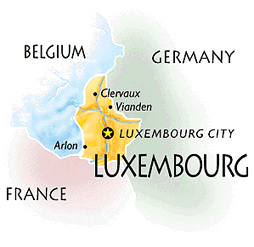
 The founder of the first
Luxembourg dynasty, Count Sigefroid, built his castle in 963. Over the centuries, a
formidable fortress developed at Luxembourg City. The remaining walls and tunnels testify
to the Grand Duchy’s turbulent history.
The founder of the first
Luxembourg dynasty, Count Sigefroid, built his castle in 963. Over the centuries, a
formidable fortress developed at Luxembourg City. The remaining walls and tunnels testify
to the Grand Duchy’s turbulent history.
Points of Interest
Area: 999 square miles (smaller than Rhode Island). Population: 422,000
(Luxembourg City, 120,000). Language: Luxembourgish, French, German. English is
widely spoken.
Highlights
Luxembourg City, capital of the Grand Duchy, is a cosmopolitan center with fine museums, art galleries, theaters, concert halls, chic boutiques, inviting shopping malls and restaurants.
A walking tour, "1,000 Years in 100 Minutes," leads from recent 10th-century castle excavations along the fortress ramparts to the lower historical town.
A miniature train ride is a delightful way to tour the valley and the remaining fortifications, which have been transformed into charming parks with pleasant walks. The Casemates are a 12-mile network of underground passages, hewn from rock.
The city is headquarters for the European Union Court of Justice, the Investment Bank, the Court of Auditors and the General Secretariat of the European Parliament.
Excursions can be made from the capital to the Ardennes; through the scenic Valley of the Seven Castles and to the Moselle wine region.
Vianden dates to the 9th century. Its castle was the cradle of the Orange-Nassau dynasties. Also of interest is the restored Gothic Trinitarian Church and cloister, dating to 1248. The house where Victor Hugo stayed during part of his exile from France is now a museum.
Mondorf-les-Bains, close to the French border, has a thermal spa, fitness and sports center and casino.
